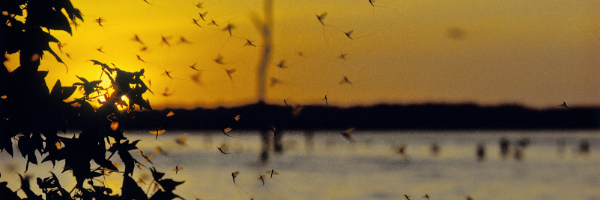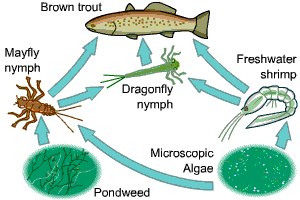03
Feb
Save Mayflies and the Ecosystems that Depend on Them
 (Beyond Pesticides, February 3, 2020) In more bad news from the insect world, recent research published in the Proceedings of the National Academy of Sciences reveals a precipitous decline in numbers of mayflies where they have been historically abundant. The research finds that in the Northern Mississippi River Basin, seasonal emergence of burrowing mayfly (genus Hexagenia) adults declined by 52% from 2012 to 2019; in the Western Lake Erie Basin, from 2015 to 2019, the reduction was a shocking 84%. Neonicotinoid insecticides are a significant factor in this decline because mayflies are extremely vulnerable to their impacts, even at very low exposure levels.
(Beyond Pesticides, February 3, 2020) In more bad news from the insect world, recent research published in the Proceedings of the National Academy of Sciences reveals a precipitous decline in numbers of mayflies where they have been historically abundant. The research finds that in the Northern Mississippi River Basin, seasonal emergence of burrowing mayfly (genus Hexagenia) adults declined by 52% from 2012 to 2019; in the Western Lake Erie Basin, from 2015 to 2019, the reduction was a shocking 84%. Neonicotinoid insecticides are a significant factor in this decline because mayflies are extremely vulnerable to their impacts, even at very low exposure levels.
Ephemeroptera to entomologists—“mayflies” to the rest of us—is an insect order comprising keystone species, on which other species in an ecosystem are very dependent, and without which, the ecosystem would undergo drastic change. The plummeting mayfly “count” is especially alarming because mayflies are a critical, primary food source in aquatic and terrestrial ecosystems, and provide an important ecological service. As the research study notes, “Seasonal animal movement among disparate habitats is a fundamental mechanism by which energy, nutrients, and biomass are transported across ecotones. A dramatic example of such exchange is the annual emergence of mayfly swarms from freshwater benthic [lake or river bottom] habitats. . . . Annual . . . emergences represent the exchange of hundreds of tons of elemental nutrients, thousands of tons of biomass, billions of organisms, and trillions of calories worth of energy to the surrounding terrestrial habitat. . . . A single emergence event can produce 87.9 billion mayflies, releasing 3,078.6 tons of biomass into the airspace over several hours.” According to Purdue University ecologist Jason Hoverman, PhD, “Mayflies serve critical functions in both aquatic and terrestrial ecosystems. Because of their important role as prey, reductions in their abundance can have cascading effects on consumers throughout the food web.” Without this critical keystone species, an important food source and nutrient recycler would be lost.
Thus, although neonics are directly toxic to many insects, the role of pesticides in destabilization of ecosystems is not necessarily direct. Beyond direct toxicity, pesticides can significantly reduce, change the behavior of, or destroy populations of plants and animals. These effects can ripple up and down food chains, causing what is known as a trophic cascade. The loss or reduction of populations at any trophic level—including amphibians, insects, or plants—can result in changes that are difficult to perceive, but nonetheless equally damaging to the stability and long-term health of an ecosystem.
Three phenomena account for most of the decrease in mayfly populations: (1) dramatically increased use of neonicotinoid pesticides, to which mayflies are highly sensitive; (2) algal blooms, especially in Lake Erie, caused primarily by runoff of agricultural fertilizers and other nutrient-dense pollutants; and (3) the warming impacts of the climate crisis, which include higher water temperatures that can wreak havoc with the development of these tiny creatures.
Because the threats to mayflies cut across regulatory boundaries, it is important for federal agencies to cooperate in protecting them. Action must be taken to protect vulnerable waterways from neonicotinoid contamination. The frequency of detections in U.S. waterways cannot be overlooked. Such routine detections, even at low levels, indicate that our waterways are being overloaded with mobile and persistent chemicals at highly elevated concentrations. Thus far, little action has been taken to restrict the use of these chemicals in response to the independent scientific literature and EPA risk data that identify direct threats to aquatic invertebrates, as well as indirect threats to higher trophic organisms. Federal benchmarks based on testing on insensitive species are not protective of more sensitive species. Similarly, action is needed to prevent runoff from agricultural fields and feedlots and adopt climate-friendly policies.
Letter to Congress
I am writing to call your attention to a serious ecological problem that requires a coordinated effort across government agencies.
Recent research published in the Proceedings of the National Academy of Sciences reveals a precipitous decline in numbers of mayflies where they have been historically abundant. In the Northern Mississippi River Basin, seasonal emergence of burrowing mayfly adults declined by 52% from 2012 to 2019; in the Western Lake Erie Basin, from 2015 to 2019, the reduction was a shocking 84%.
The plummeting mayfly “count” is alarming because mayflies are a critical, primary food source in aquatic and terrestrial ecosystems, and provide an important ecological service. As the research study notes, “Seasonal animal movement among disparate habitats is a fundamental mechanism by which energy, nutrients, and biomass are transported across ecotones…A single emergence event can produce 87.9 billion mayflies, releasing 3,078.6 tons of biomass into the airspace over several hours.”
According to Purdue University ecologist Jason Hoverman, PhD, “Mayflies serve critical functions in both aquatic and terrestrial ecosystems. Because of their important role as prey, reductions in their abundance can have cascading effects on consumers throughout the food web.” Without these critical keystone species, important food sources and nutrient recyclers would be lost.
Three phenomena account for most of the decrease in mayfly populations: (1) dramatically increased use of neonicotinoid pesticides, to which mayflies are highly sensitive; (2) algal blooms, especially in Lake Erie, caused primarily by runoff of agricultural fertilizers and other nutrient-dense pollutants; and (3) the warming impacts of the climate crisis, which include higher water temperatures that can wreak havoc with the development of these tiny creatures.
Because threats cut across regulatory boundaries, it is important for federal agencies to cooperate in protecting mayflies. U.S. waterways are being overloaded with mobile and persistent chemicals at highly elevated concentrations. Little action has been taken to restrict the use of toxic chemicals despite independent scientific literature and EPA risk data that identify direct threats to aquatic invertebrates, as well as indirect threats to higher trophic organisms. Similarly, action is needed to prevent runoff from agricultural fields and feedlots and adopt climate-friendly policies.
Thank you,











Please defend the environment, all insects are part of the environment in the circle of life.
February 4th, 2020 at 6:03 am